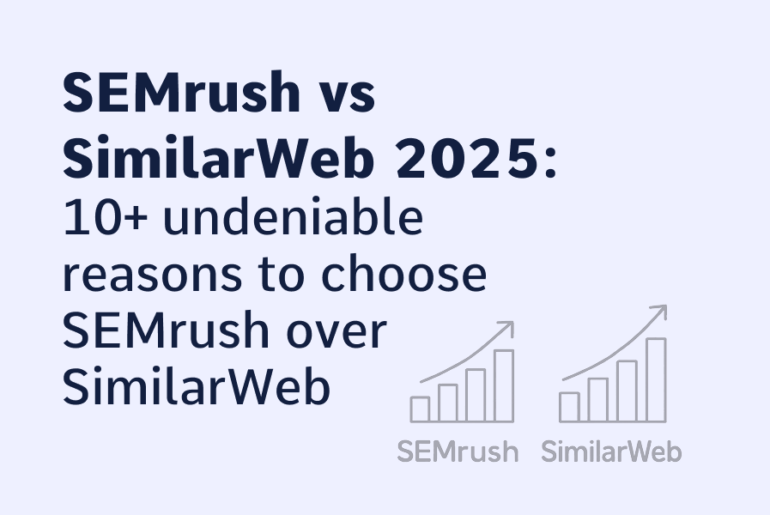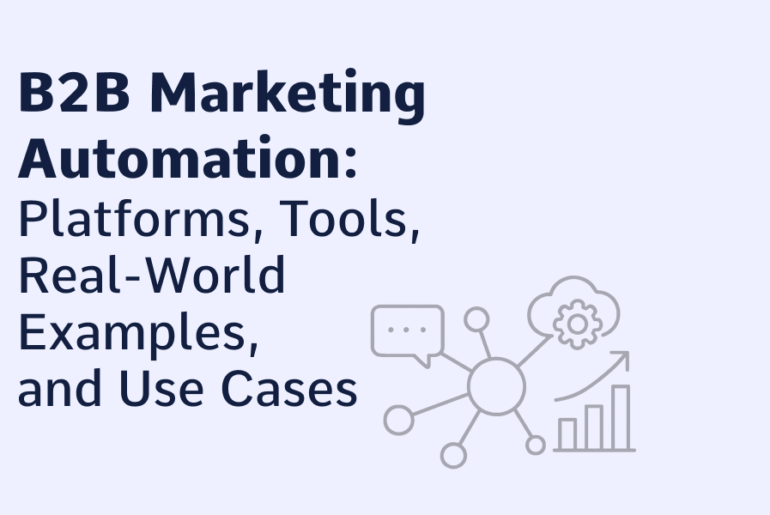Sending cold emails can be challenging, much like making cold calls. However, when done correctly, cold outreach can generate high returns on investment (ROI) and help grow your business. With minimal capital required, cold outreach can effectively land sales and create the cash flow needed to get your business up and running.
This guide on cold outreach covers everything you need to know, from setting up your first email to achieving a high conversion rate. Feel free to navigate between sections if you are already familiar with certain aspects of email outreach.
Cold outreach in B2B: key statistics
- Response rates: On average, cold email campaigns have a response rate of approximately 1-5%.
- Multi-channel efficiency: Integrating cold calling with email outreach can increase success rates by up to 128%.
- Personalization impact: Personalized emails deliver 6x higher transaction rates.
- Optimal contact times: The best day to send a cold email is Tuesday, with the highest open rates.
- Follow-up frequency: It takes an average of 18 touches to connect with a buyer.
- Email volume: Over 306 billion emails are sent and received each day, highlighting the importance of a standout approach.
- Decision maker reach: Only 2% of cold calls result in a meeting with a decision-maker.
- Email open rates: Subject lines with the recipient’s name can increase open rates by up to 22%.
- ROI of email marketing: Email marketing has an average return on investment (ROI) of $42 for every $1 spent.
- Lead conversion: B2B companies with mature lead generation processes enjoy 133% more revenue compared to average companies.
Quickly select the right tool for your needs:
snov.io
●Suitability: Sales and marketing professionals
● Features: Email finding and verification, email sending platform, CRM integration
● Advantages: Automates lead generation, manages sales pipelines, improves outreach efficiency
Hostinger Business Email
● Suitability: Small to medium-sized businesses
● Features: Ad-free business email, integrated calendar, contacts, and tasks
● Advantages: High privacy, seamless integration with the Hostinger hosting
hostinger
● Suitability: Website owners, small businesses, startups
● Features: User-friendly website builder, WordPress optimization, various hosting options
● Advantages: Affordable pricing, ease of use, 24/7 support
warmy.io
●Suitability: Email marketers, sales teams
● Features: Email warming, automated engagement
● Advantages: Enhances email reputation, improves deliverability and open rates
warmupinbox.com
● Suitability: Individuals, businesses aiming for better email deliverability
● Features: Automated email sending and interaction, sender reputation building
● Advantages: Simple user experience, avoids spam filters, improves email engagement
uplead.com
● Suitability: B2B marketers, sales professionals
● Features: Lead database, real-time verification, chrome extension
● Advantages: Accurate lead data, enhances conversion rates, simplifies prospecting
apollo.io
● Suitability: Sales teams, marketers
● Features: Prospecting, automated sequences, dialer, analytics
● Advantages: Streamlines sales process, extensive database, all-in-one platform
zoominfo.com
● Suitability: B2B companies requiring detailed customer insights
● Features: Large company and contact database, business insights
● Advantages: Supports targeted campaigns, rich data, multiple tool integrations
phantombuster.com
● Suitability: Growth hackers, marketers
● Features: Data scraping, lead generation, web task automation
● Advantages: Customizable scripts, complex task automation without coding
hunter.io
● Suitability: Individuals, companies seeking professional email addresses
● Features: Email finding, verification, outreach tools
● Advantages: Streamlined B2B communication, easy to use
usebouncer.com
● Suitability: Email marketers
● Features: Real-time email verification, list cleaning
● Advantages: Reduces email bounce rates, increases campaign effectiveness
hyperise.io
● Suitability: Marketers looking for engagement through personalization
● Features: Image personalization for email, SMS, social media
● Advantages: Creates engaging campaigns, personal touch increases conversion rates
make.com
● Suitability: Businesses automating workflows
● Features: Visual integration builder, supports numerous apps
● Advantages: No technical knowledge needed, visual interface, complex automation made easy
What’s a B2B cold outreach? And what makes it different from spam?
Every cold contact needs a warm introduction. Understand the person, not just the position they hold.KEITH FERRAZZI, NETWORKING SPECIALIST.
Cold emailing is a prospecting method involving contacting an unfamiliar person to establish a relationship that will ultimately result in a sale or partnership. This approach can be used on various outreach platforms such as LinkedIn, Twitter, and direct mail, but my experience shows that cold emailing is often more effective. Here are a few instances of how various businesses utilize cold outreach:
- B2B startups cold outreach corporations to sell their products.
- Freelancers email business owners to propose their services.
- Entrepreneurs reach out to investors to present their proposals.
It’s the value a message brings that separates spam from cold email. Not all cold outreach is spam; spam refers to poorly written, unsolicited messages sent in bulk. Any dishonest or irrelevant message is considered spam.

To prevent your cold emails from ending up in the spam folder, what does this mean for your outreach efforts?
- Target the right people. Contact only individuals who match your target audience’s criteria.
- Deliver relevant value. Provide something that will genuinely benefit them.

We will demonstrate how to create successful campaigns later on.
B2B cold outreach vs. B2B warm outreach (B2B email marketing)
Before we begin, it’s important to note that cold emailing differs from traditional email marketing. Cold outreach refers to contacting potential clients with whom you have no prior relationship and who may not be aware of your product or service. On the other hand, warm outreach involves reaching out to people who are already familiar with your offerings and have expressed interest in them.

When it comes to email marketing, most people think of inbound marketing, where users willingly sign up to receive emails. Inbound marketing also includes SEO and content marketing. However, cold emailing is considered outbound marketing, where a company initiates contact with users without prior permission.
Therefore, it is essential to use different email tools for cold outreach. It’s worth noting that several email service providers (ESPs) and customer relationship management (CRM) platforms used for email marketing do not permit cold emailing. Some of the examples include ActiveCampaign, Brevo, and HubSpot.
Are B2B cold outreach legal?
Cold outreach is not just about sending emails, it’s about starting a conversation.NEIL PATEL, MARKETING EXPERT.
In the B2B world, it’s essential to understand the regulations around cold emailing. It is legal, but specific guidelines must be followed depending on your location and target audience. In the United States, the 2003 CAN-SPAM ACT permits cold emailing as long as you adhere to five specific guidelines:
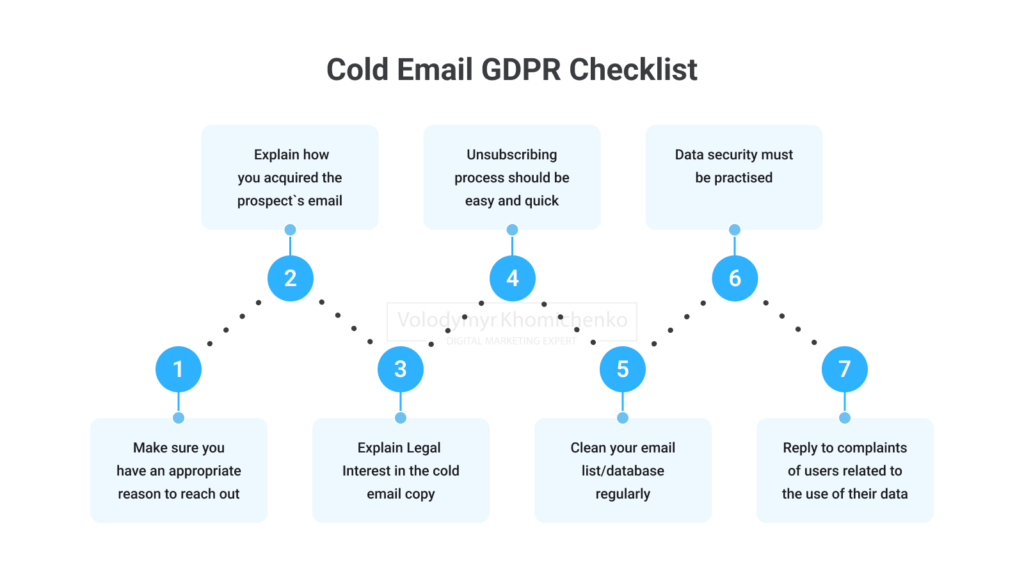
- Give users the ability to opt-out: This can be as simple as an unsubscribe link or a line like “Please let me know if you’d like to stop getting emails from me.”
- Remove opted-out recipients from your email list within 10 days of opting out: Understandably, manual opt-outs get tricky with more extensive email lists, so I recommend using an outreach tool to help automate this.
- Don’t use misleading subject lines: Using a subject line irrelevant to the email’s content is illegal, such as “You’re in danger.”
- Use an honest sender name: Like subject lines, your “From” address should accurately represent you or your business.
- Include your company’s physical address: A few other acceptable alternatives include providing the address of a registered P.O. box, your rented or owned studio space, or the contact information of a professional representative.
If you contact people living in the European Union through cold emails, you must follow the General Data Protection Regulation (GDPR) guidelines.
These guidelines state that you must have a valid reason for contacting them, disclose how you obtained their email address, provide an easy way for them to unsubscribe, and regularly clean your contact database. Following these guidelines, you can send cold emails in compliance with GDPR.
The bottom line: Before sending cold emails, research and comply with regulations in your and your prospects’ locations.
Regulatory compliance in B2B cold outreach
In today’s digital marketing landscape, regulatory compliance is not just a legal requirement but a cornerstone of trust and credibility in B2B relationships. Navigating through laws like GDPR in Europe and the CAN-SPAM Act in the United States is essential for any business engaging in cold outreach.
GDPR and Its Implications: The General Data Protection Regulation (GDPR), effective from May 2018, has reshaped the way businesses handle personal data in the European Union. It requires explicit consent for data processing and gives individuals the right to access their data. Non-compliance can result in hefty fines, with statistics showing that GDPR fines totaled €272.5 million from May 2018 to January 2021.
Under GDPR, businesses must ensure that personal data is collected legally and under strict conditions. They must also protect it from misuse and exploitation while respecting the rights of data owners.
CAN-SPAM Act Compliance: In the United States, the CAN-SPAM Act sets the rules for commercial email. It establishes requirements for commercial messages, gives recipients the right to have you stop emailing them, and spells out tough penalties for violations. According to the Federal Trade Commission, the CAN-SPAM Act allows for fines of up to $43,792 per violation.
The Act emphasizes transparency, requiring that your emails are not deceptive in subject lines and headers. It also mandates that every email includes an easy way to opt out of future emails.
Benefits of cold outreach
The best cold outreach campaigns are built on a foundation of research, not assumptions.JILL KONRATH, SALES STRATEGIST.
Cold outreach has a lot of advantages that can be beneficial to grow businesses. Let’s see the top benefit of implementing cold outreach in your company.
- Targeting: With emails, you can focus on specific individuals. This allows for more personalized messaging that can increase the chances of a successful outcome. On the other hand, ads tend to have a broader reach, which means that they may only sometimes be effective in reaching your target audience.
- Cold outreach is cost-effective: You can start your outreach process with just an email account; no need for a budget for ads, event planning, or advertising.
- It’s scalable: Automated tools can send many people hyper-personalized cold emails and follow-ups at once. Analyzing reports on click-through, open, and bounce rates can help identify effective outreach tactics and avoid mistakes for future success.
- Access: Decision-makers often manage their own inboxes, making it crucial to have the correct email address to reach them.
- Broader brand exposure: Therefore, cold outreach provides more comprehensive brand visibility, as cold emails and LinkedIn outreach can reach anyone worldwide.
- Low capital investment: Many email software tools are available to automate your outreach. You only need an email account to start immediately and avoid spending money before generating revenue.
What kinds of companies make the most from cold outreach?
Businesses that offer B2B services, high-priced products, or niche solutions often benefit significantly from cold outreach. This is because they usually cater to a specific customer base where personalized and direct communication tactics are more successful in driving sales and conversions. Examples include companies in the software, financial services, and manufacturing sectors.
Based on my extensive experience collaborating with numerous startups, I have found that cold emailing is the most effective approach for:
High-margin products: High-margin products often yield the most success in cold outreach because the profit potential justifies the effort and resources expended in the outreach process. Additionally, the inherent value of high-margin products can make them more attractive to prospective clients, increasing the likelihood of successful conversion.
Early-stage startups: Early-stage startups benefit significantly from cold outreach, allowing them to quickly build their customer base and generate interest and awareness about their products or services. Additionally, it will enable them to receive immediate feedback and adjust their value propositions better to meet the needs and priorities of their potential customers.
Here are more specific types of companies that we’ve seen it work well for:
- B2B SaaS businesses
- Products not actively searched
- Agencies that charge thousands of dollars per month for each client.
- Companies that sell high-priced physical items, such as gym equipment or medical devices.
If you need help determining whether to test cold outreach, use this framework to help you decide. If you meet either or both of the following criteria, consider trying cold outreach:
- Your profit margins exceed $1000 per closed deal with a payback period of under three months.
- You are currently at the traction stage of your business. Often, selling at lower margins is necessary to get off the ground. The goal is to focus on non-scalable tasks until you can afford to test scalable channels.
Main rules of cold outreach
Personalization in B2B outreach is not optional; it’s the key to breaking the ice.
ANN HANDLEY, CONTENT MARKETING LEADER.
When running a cold outreach campaign, following specific rules is essential. Let’s review them.
Show that you care: For a potential prospect to seriously consider your offer, showing them that you genuinely care about their needs is essential. This means taking the time to research and understand their pain points and crafting a personalized email that offers an irresistible solution. Only then will they feel valued and be more likely to engage with your offer.
Do not demand attention: Following someone or regularly consuming their content doesn’t guarantee their attention or consideration of your offer. Sincere effort is necessary.
Do not sound robotic in your emails: You may have noticed many emails in your inbox sent by a computerized bot. These types of emails could be better. Ensure that the message you compose doesn’t sound robotic. It should be personalized, contain some humor, and be relatable.
Be genuine: It’s essential to be honest about the offer you’re presenting. Avoid exaggerating or misrepresenting your product or service. Your audience is likely intelligent and will be able to detect any dishonesty.
Don’t waste any time: When sending an email, be concise and considerate. Take time to research the recipient and write a message that is relevant to them.
21 Cold Outreach Email Best Practices
In this section, we shall discuss the cold emailing tips & best practices that will help your business to get results. Let’s differ on how to do this effectively.
1. Understand your targeted audience: Before executing a successful campaign, you must research and understand buyer personas, knowing your target prospect and their needs or pain points. You can easily create a customer-centric approach and convince them through your offering’s value and positive impact on their lives.
2. Avoid focusing only on selling: If you want to respond and build relationships with your potential buyers, stop selling your product/service. Instead, share the benefits of your offerings. By aiming to connect with the ideal customer, you can begin your sales on the follow-up sequences.
3. Make it short and concise: Outreach messages for prospective customers must be as concise as possible. You must keep 2-3 sentences and paragraphs short of grabbing their attention. It is good to have 100 words to enhance the context’s readability. To increase engagement with your message, briefly mention the product or service rather than tell a long story.
4. Employ a catchy subject line: You must be creative in your subject lines to get people’s attention. A boring, uninspiring subject line will turn off prospects no matter how well-written the email’s body is.
So, ensure you’re providing enough ‘hooks’ to make them want to read your message. Think about what they need right from the subject line so that they can connect with you better and feel interested enough to read the email.
Another best method to make your ideal email subject stand out is by evoking curiosity, fear of missing out (FOMO), a sense of urgency, and excitement. If you include these in your subject lines, the recipient will likely be attracted to your message.
5. Concentrate on the intro: The research found that an opening line will help you connect with your audience, so take some time to write an exciting and personal opening line. This can make or break an email if you need help getting it right. It is vital to mention a common interest or pain point to provoke their interest and help them understand your message.
6. Focus on personalization: Personalizing your messages is essential to increase your chances of receiving responses when contacting cold prospects. While it may seem challenging to personalize every message when getting many potential clients, there are other options than neglecting proper personalization. According to ZoomInfo statistics, email personalization can double your reply rate, making it a crucial factor in successful outreach.
7. Keep the language simple: When writing an email to a potential customer, it’s important to avoid using technical or industry-specific language that may be unfamiliar to them. Instead, aim for a conversational tone and use simple language to help the reader understand your message. This will make your email more approachable and increase the chances of a positive response.
8. Address prospects pain points: It’s essential to address the potential customer’s concerns to increase the chances of a reply. By offering solutions and tips to overcome objections, the customer is more likely to show interest in your brand. Researching customer pain points and communicating how your product or service benefits them is crucial.
9. Connect on a human level: It’s important to address pain points without being too sales-focused. Remember that your prospects are people; connecting with them personally is crucial. Sales representatives who show genuine concern for potential customers and a desire to help them improve their businesses are more likely to achieve higher conversion rates.
10. Give valuable resource to the customer: When reaching out to a prospect, one way to build trust is by offering them a valuable resource. They’ll trust you more when you do something for them without expecting anything in return.
According to psychology, the customer will be more inclined to reciprocate by giving you something in return. So, if you provide something of value, the customer will likely respond by giving you something in return later. It may be purchasing your product or referring to your company, which can be helpful for you.
11. Put in effort & add values: If you want to impact through your email, you need to ensure it is worth reading. Your outreach message will have no response and click-through rate if it is generic and unconvincing. You require time & effort to know your target prospect and their need to make your outreach message stand out from the other messages in your ideal customer email inbox.
12. Try to give social proof: You have to show your prospects that you’re not just promising them something but instead offering a service they can rely on. To be convincing, you must show them evidence of your corporate success.
You need to mention previous clients’ success stories, statistics, and reviews of products/services so the person receiving your outreach message knows what results others have after using your services.
13. Use emojis: B2B emails should be strictly professional and straightforward, but it’s okay to inject some humor into them. In fact, prospects may appreciate it. Emojis can also make your email more engaging and relatable to your intended audience.
14. Having the right CTA: Ensuring that your offer corresponds to the call-to-action (CTA) used is crucial. For example, If you’re offering an e-book, you can ask them to reply “yes,” and I’ll send them a copy. If your business gives away tickets to an event, you can ask them to reply “yes,” and I’ll reserve a spot for them.
15. Perform an A/B test: To better reach your audience, try A/B testing your emails. This involves testing two versions to see which performs better. Remember, one template won’t work for everyone, so test different messages to see what works best for your target prospects.
16. Add an email signature: When concluding your email, include a professional-looking email signature. Keep it concise, but include pertinent information such as a link to your company’s website and contact details. This lets the recipient learn more about your company by visiting your website.
17. Spot the typos: Before sending your email, please take a moment to proofread it and check for any spelling mistakes. Consider using a tool (like Grammarly or Language tool) to correct your spelling and grammar to save time. Ensuring your emails are error-free is essential for making a good impression and may lead to positive outcomes.
18. Test your outreach before launch: Ask colleagues to review your emails before sending them out to find any necessary improvements. You’ll get a better working response rate this way.
19. Catch on follow-ups: Cold outreach is only effective with follow-ups. Having follow-up plays a significant role in winning your cold campaigns. Follow-up will help you generate new connections, resulting in a sale when used correctly.
You can turn NO to YES among potential buyers by implementing follow-up sequences. However, they must be tailored to the audience, so start creating and scheduling a specific follow-up.
20. Use additional domains and email addresses: To scale and reach many customers, more than one email is needed. You need to create a network of domains and emails. How to do it specifically will be discussed later in this guide.
21. Go with automation: If your company has to handle high volumes of emails, you’ll need the support of email automation tools. Use these tools to personalize and scale the outreaches.
Automation helps split test the campaigns and can easily set up the outreach and their follow-up email sequences on the targeted customer time zone, resulting in increased open rate & click-through rate. The deeper insight reporting of the outreach process helps set up an effective campaign next time.
Where can you go wrong with your cold outreach?
Rejection is something you learn to accept as a natural part of cold outreach in B2B. What matters is what you do next.BRIAN TRACY, SALES TRAINING EXPERT.
Have you ever experienced your leads ignoring your cold emails and follow-up messages? It can be frustrating, but there may be some factors to consider to improve your outreach campaign. Let’s explore some potential shortcomings that could be impacting your success.
- Irrelevant to recipient
Before sending outreach emails, ensure your offer is pertinent to your audience. To achieve this, it is vital to have a comprehensive understanding of your target audience. - No OOH moment
When crafting a cold email, it’s essential to think creatively. Please don’t rely on clickbait alone; consider what will capture your reader’s attention and keep them engaged beyond the subject line. With an attention-grabbing factor, your email can maintain its impact on your audience. - No AHA moment
Once you have captured your readers’ attention, highlighting your offer’s value is essential. They will likely respond and seek further information if your offer resonates with them. This can lead to a successful outcome for both you and your audience. - Vague request
Write a specific email that gets to the point to avoid being ignored. - Clarity about your company
When reaching out to people, focus on clarity over fame. Ensure your audience understands your company and product’s usefulness.
11 steps process to set up an effective cold email campaign
Register domains, choose email provider, and create email boxes.
I think you immediately have a question:
Why should I register new domains if I already have the main domain where my website is located?
That is the right question. So I will tell you more. When you start cold outreach, different things can happen. Even if you send relevant, adequate emails to the most interested audience, many people may not like it and may send these emails to spam and complain to their provider (e.g. Gmail).
This can jeopardize your main domain and your employees’ emails. It can get blacklisted, and even your internal corporate email may not reach the recipients, or all get spammed. You don’t want to be in that situation. I don’t think so, either. That’s why we take precautions.
We register new domains, create mail, and send from them. It’s self-explanatory. Now, you may have the following questions:
How many domains do I need, and how many emails do I need?
Let’s do the math. You can safely send 50–80 emails from your new account daily. I recommend creating no more than 2–3 mailboxes per domain. If you have a base of 10,000 contacts to whom you want to send your emails within one month, you need the following:
10000/20=500 letters per day (I excluded weekends and holidays)
500/50=10 (how many mailboxes do you need if you send 50 emails daily from each).
10/2=5 (you need to buy 5 domains if we will create 2 mailboxes on 1 domain).
As you can see from our calculations, we need to buy 5 new domains. You will have your figures. Always focus on your goals and the results you want to get. That’s all well and good, but many more readers will ask this question:
How many people should I send an email to? My goal is to get a certain number of orders or leads. What should I do in this case?
It’s more complicated than that. Because no one can guarantee you specific numbers. Every business industry, and even product, has its numbers. I will share with you the approximate numbers you can have if you follow this guide and do everything right:
- Aim for an open rate of at least 75% for a successful cold email outreach campaign. If you achieve over 87%, your campaign is considered very successful.
- Good cold email response rates can vary greatly, with some sales emails having a 5% rate and others reaching over 40%. The average response rate for cold emails is only around 1%.
To get 10–50 leads (booked calls), you only need to send 1000 emails. It’s pretty realistic! But to achieve such a conversion rate, you need a quality audience and a very high-quality message that you will deliver to them (and know many other things).
We’ll talk about that later in this guide. So, let’s get back to domains.
Where is the best place to buy a domain?
Now, buying a domain is very easy. I will not dwell here long. You have already done it, I’m sure, more than once (or ask your marketer to do it). I’ll tell you what I use and give a couple of other links if you need clarification on what provider to choose. I use – Hostinger (they have cheap hosting, and they often give domains for free).
Also, other registrars that I recommend:
From this list, you’re sure to choose to your taste
Moving on
Choosing your email provider
There are two options for email service providers to choose from:
- Paid (Zoho mail, Hostinger Business Email, Google Workspace)
- Free (Gmail, Hotmail)
My advice? Choose a paid email provider)
Here’s why:
- Creating emails with your company domain can increase trust with your recipients.
- The deliverability is much better. Because there are numerous spammers with free accounts, this leads to a bad reputation for free emails by default.
I recommend going with Hostinger Business Email or Zoho mail (It’s cheaper than Google Workspace and fully covers your needs).
Update 2025: It happens that Zoho mail started banning accounts if outreach is going on. So it is better to use Hostinger Business Email.
I’ll show you how the process works with Zoho mail as an example.
We just register
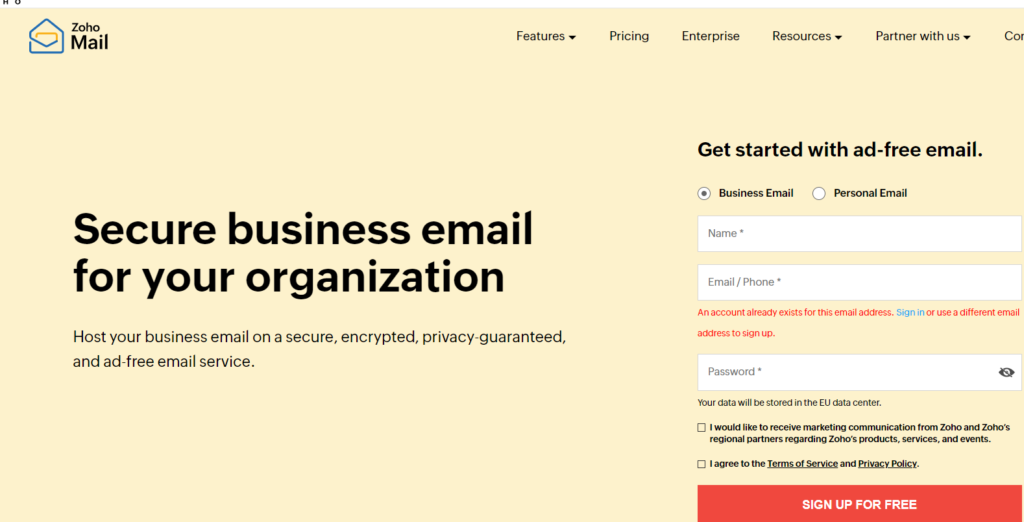
And connect the domains that we bought.
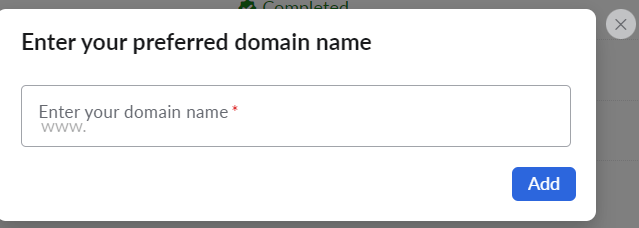
The process is complicated because you must set up SPF, DKIM, and DMARC right after connecting. SPF, DKIM, and DMARC are technical ways in which an email provider checks whether the email comes from you and not somebody else. There are two ways to set up email authentication: SPF and DKIM.
- SPF (Sender Policy Framework) is an email validation system designed to prevent spam by verifying the sender’s IP address
- DKIM (Domain Keys Identified Mail) indicates ownership of the email message by a particular organization
If you need to know a DNS, ask your programmer to help you.
Once fully configured, your domains should look like this:
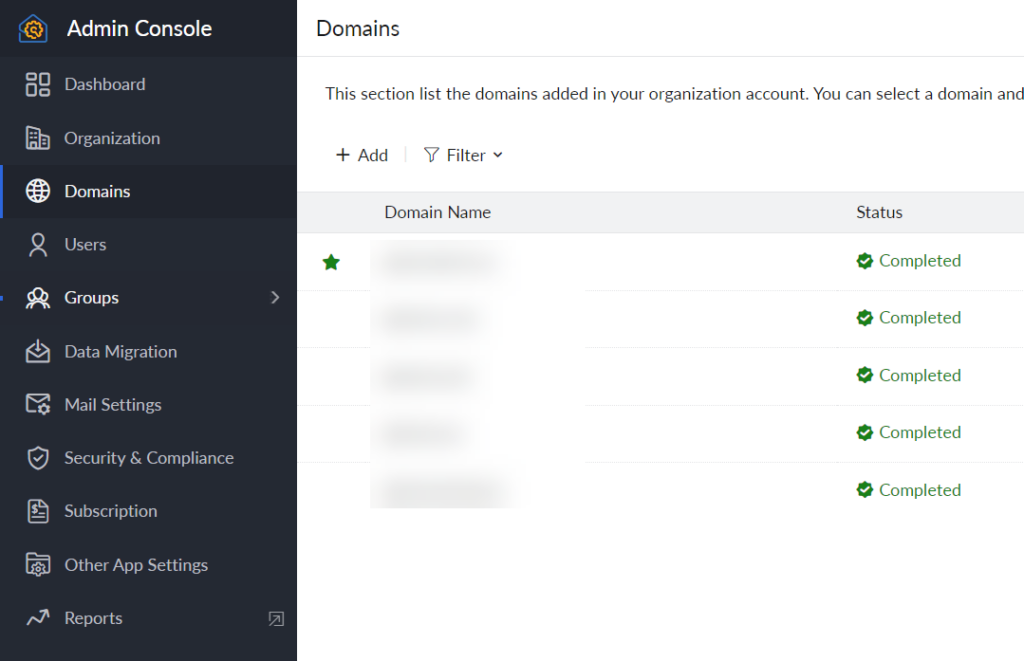
Create email boxes
After setting up domains in Zoho mail, go to the users section and create mail accounts. To start, click the “Add” button.
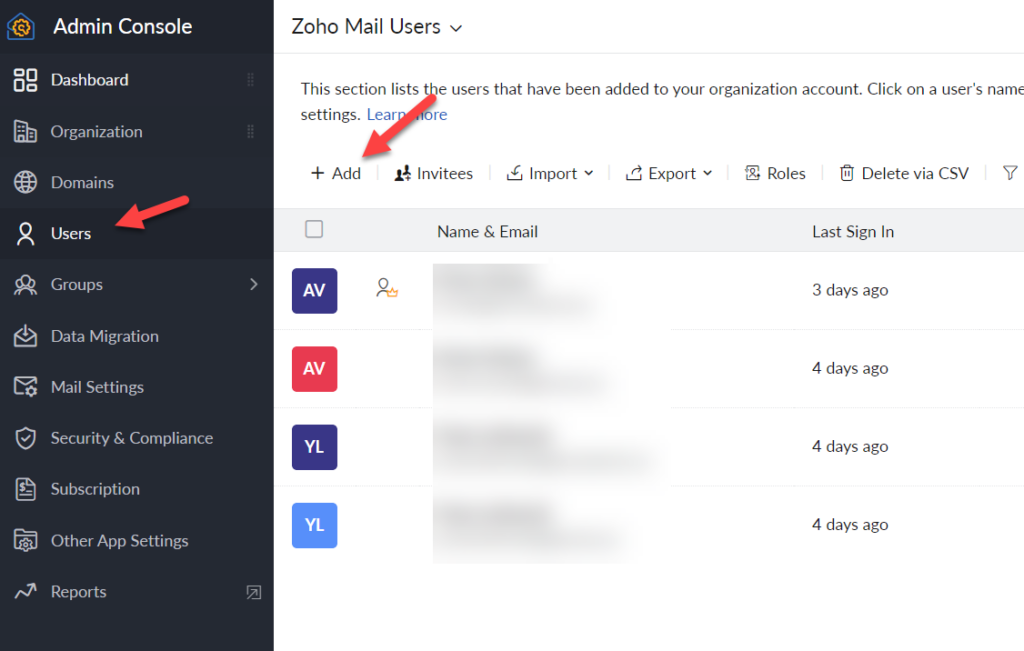
But remember the rule – add at most 2-3 email addresses for one domain!
- Select a cold outreach tool and connect mailboxes to it.
This is the most critical moment. A lot depends on the choice of cold outreach tool. I have spent a lot of time testing more than 20 different instruments.
You do not need to do this, and I will share my experience with you.
At the end of my research, I chose for myself – snov.io It is ideal for beginners in terms of price-quality ratio.
Also, not bad such cold outreach tools:
Since I’m using snov.io, I’ll use it as an example.
How to connect mailboxes to cold outreach tool
In B2B outreach, clarity trumps persuasion. Be clear about what you want and what you offer.DONALD MILLER, BUSINESS AUTHOR.
It’s very simple! Go to the email accounts section. And click on add a new one.

Choosing a Zoho

Fill in the data. If you need help finding where to get them, look at the instructions or ask your programmer to help you :).
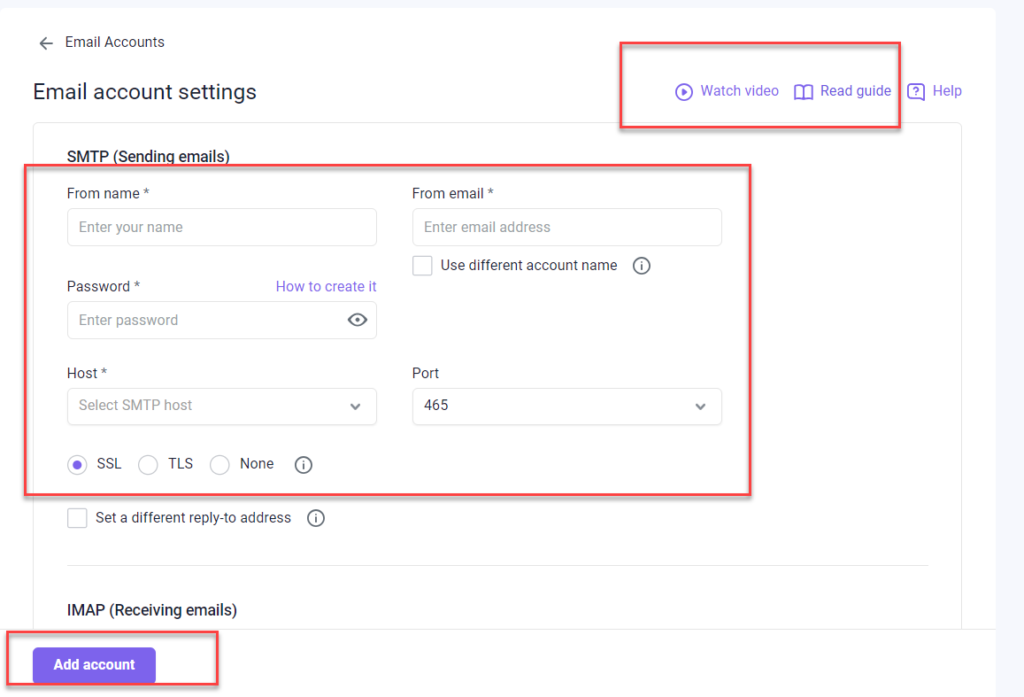
After configuration, all emails should appear in the list
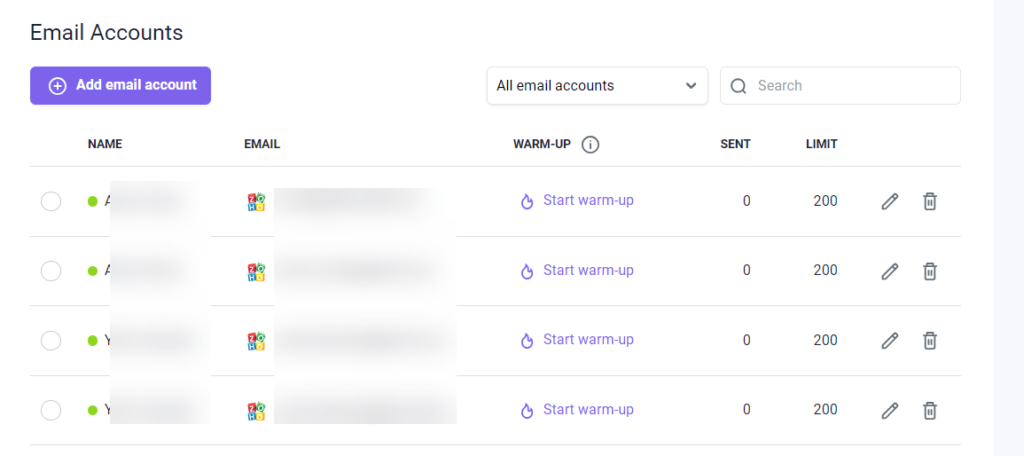
Set up your cold email outreach signature and profile
How to set up your email profile correctly?
A photo in your cold email campaign is crucial to getting replies, even if the content is excellent. Take advantage of this easy step, so please add one.
- Your True name
- Actual photo (ideal with a smile)
- Your real data
It’s also crucial that your photo looks professional. Even if you haven’t had a professional photo shoot, AI is here to help.
I recommend using this tool to create an excellent image – HeadshotPro.
Set up your email signature.
Many people often overlook the importance of a strong email sign-off and a professional email signature, which should include your:
- Name
- Current position within the company
- Physical address
- Phone number
- Company website link
Why is it essential to include your full name and contact information in your email signature?
By including an email signature, you demonstrate to the recipient that you are genuine and professional. This signature serves as your digital business card and ensures compliance with the CAN-SPAM Act discussed earlier in this guide. To further reinforce your message and encourage conversions, consider including a brief call-to-action in your signature, such as a link to your calendar for scheduling a meeting.
For instance, it may look like this:

Including a unique quote, tagline, or notable achievement in your email signature is a good idea to highlight your worth, establish credibility, and make your cold email stand out. However, avoiding too many repetitive links or unnecessary information, such as multiple phone numbers and your email address, is best.
Additionally, it’s vital to ensure that the HTML footer of your signature is tidy, as cluttered and disorganized coding can potentially trigger spam filters and take up more space than your message text.
You can customize your signature where you have configured your email accounts.
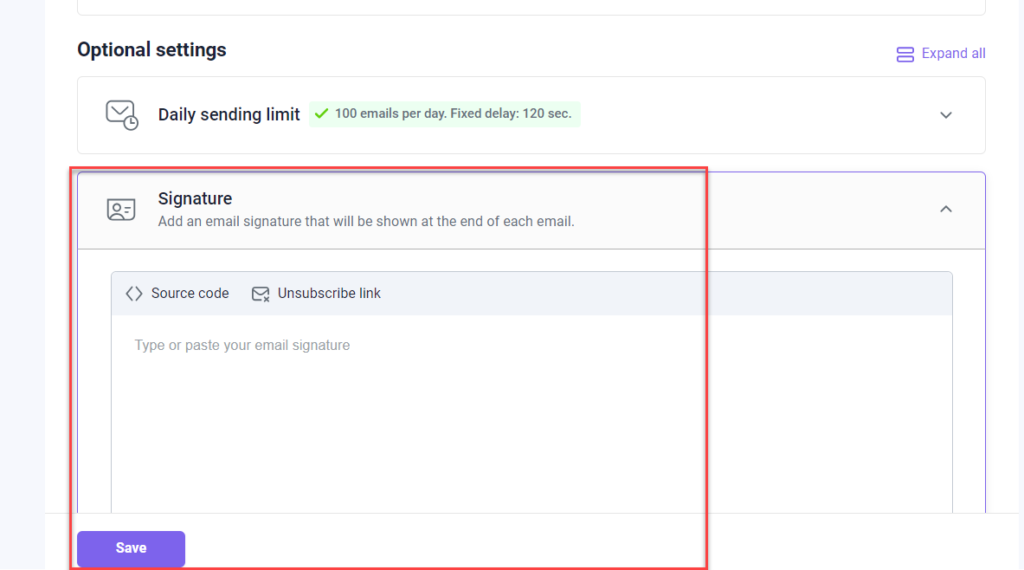
Important:
It is necessary to fill in the same data in both the Hostinger Business Email and the Snovio so that there will be no awkward situation when you answer the letter
- How to raise deliverability (best practices to avoid getting blacklisted)?
There are specific rules we need to follow when avoiding spam filters and never being trapped on a blacklist. Set up a custom tracking domain.
You need this for two reasons. To track clicks and opens, but also to ramp up your deliverability.
This is done in the same section as the signature:
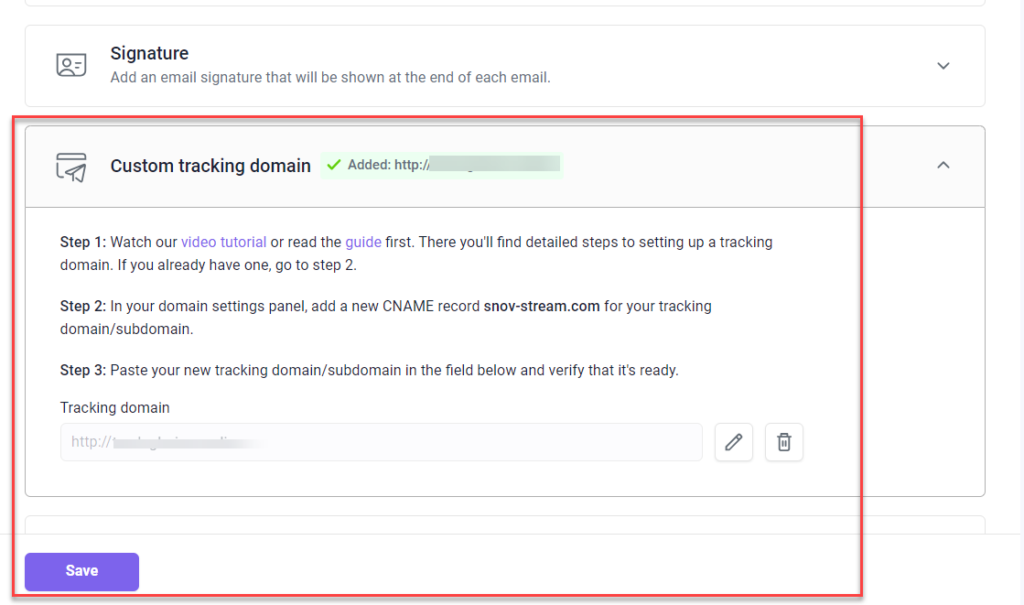
The only thing is that you need a separate domain or subdomain for this, but you already know how to buy them.
How to set it up? See also the instructions on this page.

Warm up an email account.
It’s super important for an email provider to see that you play by the rules, especially if you’ve just created your email!
This is why you should ALWAYS warm up your email account. A warmed-up email address has been sending and receiving messages like a real person does.
Snovio already has an inbuilt emails warm-up feature. You can use it as part of your tariff:
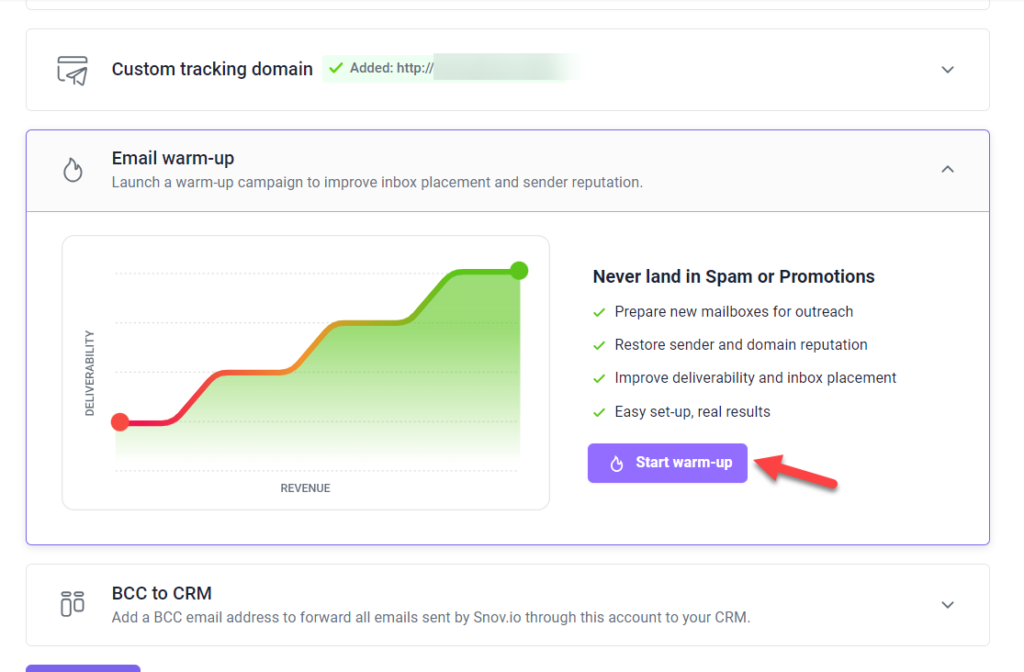
The only problem is that they have small limits.
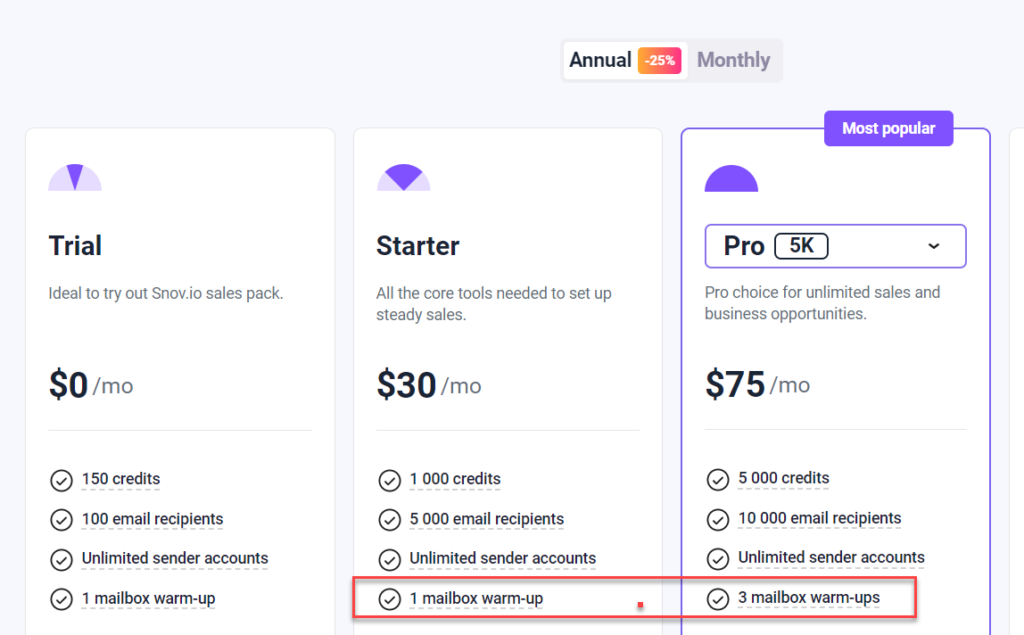
If you need to warm up 4 or more emails simultaneously, you need to buy additional tools.
I’ve tested plenty of warm-up tools. I like these two the best:
Warmupinbox is cheaper but has fewer functions:

Warmy is more expensive but also more advanced.
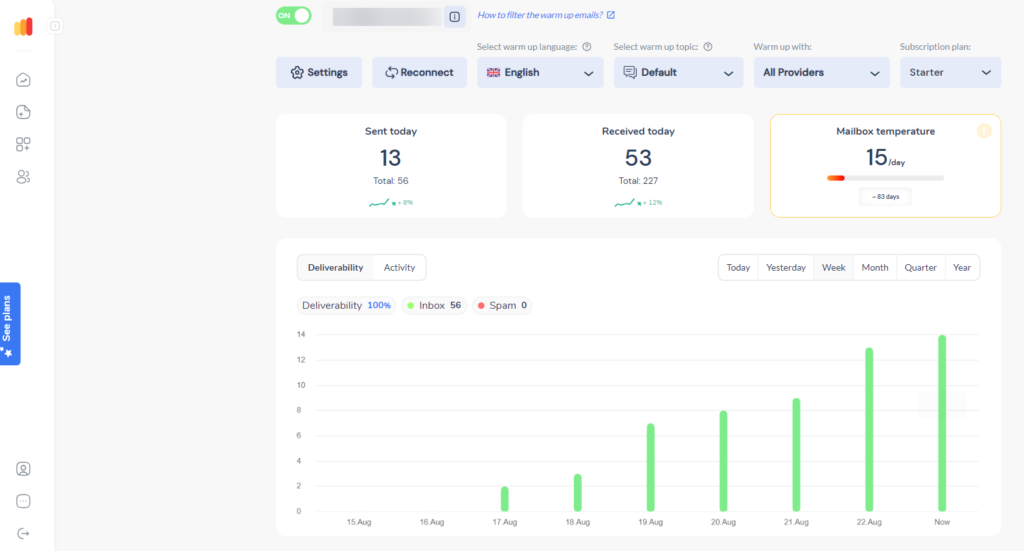
I recommend testing them both and choosing the best one for you.
Daily sending limit
It’s a tricky question! Google and other email providers have algorithms, and it’s hard to say something with a 100% guarantee.
Based on our experience, there are rules that you need to follow:
- 70-80 emails per day if your email is new (including warm-up emails)
- 100-120 emails per day if your email is old (including warm-up emails)
It is essential to start sending a little at first and build up gradually.
My algorithm:
1st week – 10 emails per day from one email address
2nd week – 20 emails per day from one email address
3rd week – 30 emails per day from one email address
4th week – 40 emails per day from one email address (at this point, turn off the warm-up)
5th week – 50 emails per day from one email address
6th week – 60 emails per day from one email address
7th week – 70 emails per day from one email address
8th week+ – 70–80 emails per day from one email address
This can be customized here. I recommend putting numbers like this:
Start with:
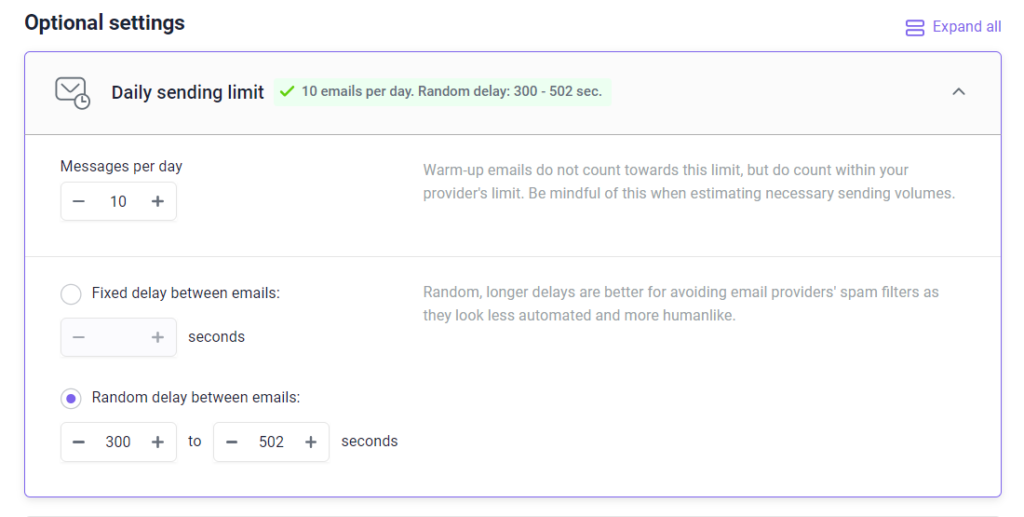
Final with:
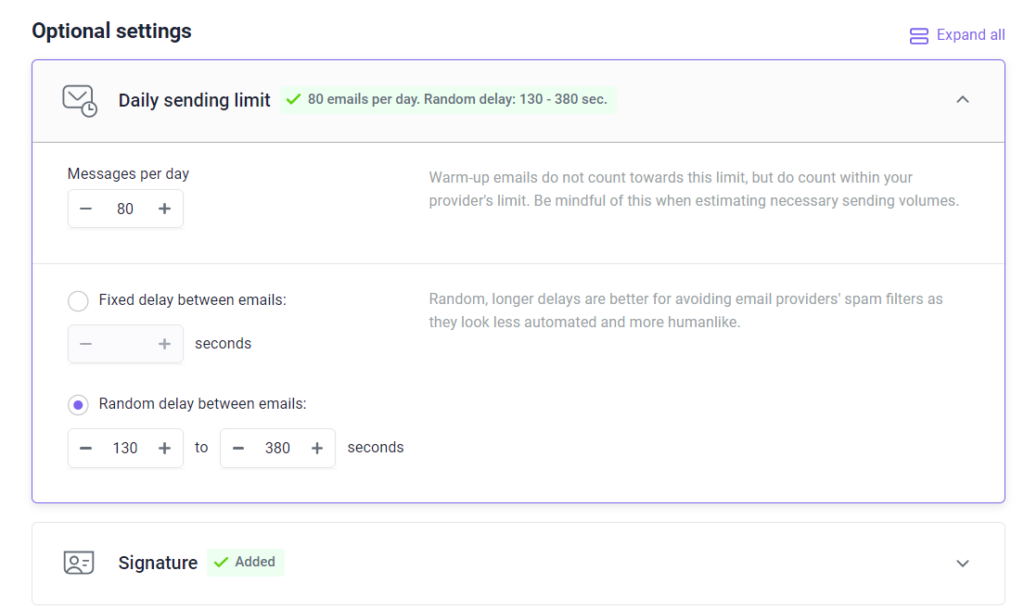
Building a cold email list
Now, I’ll show you how to find the right audience and their email addresses.
And before coming to the tools, let’s step back and find out – who is your real client?
You need an ideal customer profile and Buyer persona. This is the base without which all further efforts will be meaningless.
I wrote a separate article on this topic earlier. You can find it here. Stop now and work on this issue. Only after that move on
How do you find email addresses?
There are tons of ways to find emails—chrome extensions, databases, etc. Follow this rule firstly – don’t scrape personal emails (due to GDPR)
Snovio has a built-in lead prospecting functionality.
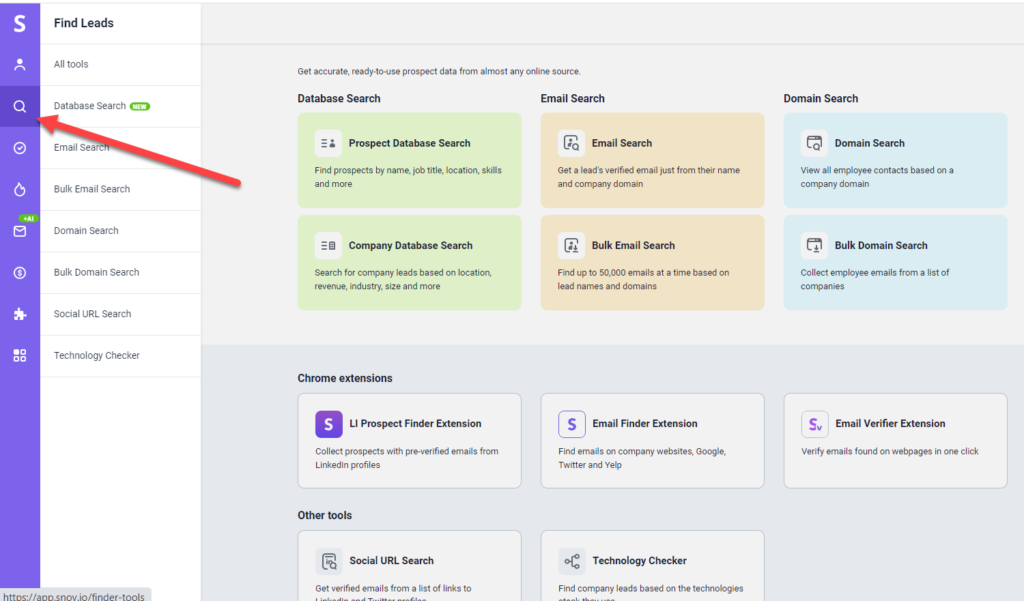
This is a rather broad topic so I won’t go into detail here. Take a look at their instructions:

If you can’t find all the leads you need with this tool, I recommend paying attention to more advanced tools.
- More advanced tools – uplead.com or apollo.io
- If you want the best quality base on the market – zoominfo.com
If this doesn’t work for you, there are other ideas for non-standard searches:
Look for aggregators to create a decent-quality list
Aggregators are basically sources of leads who gather a huge volume of lead information and resell it to their clients. So, to streamline your cold outreach, you can buy relevant lead information from a renowned aggregator. You can then send personalized and interactive emails to them and fulfill your sales and marketing objectives.
Research useful industry roundup lists: Creating roundup lists is a simple and enjoyable method of showcasing information. These lists typically feature posts such as “Top 10 Products” or “Best Tools,” and can also contain step-by-step guides or timelines on specific subjects, along with social media shares and customer feedback. Essentially, anything that can be compiled into a list can be included in a roundup list.
You can approach them with relevant and valuable offers if you identify roundup lists that align with your business. Being featured in these lists will help increase your website traffic and ultimately expand your customer base.
Reach out to influencers on social media: Using social media for cold outreaches can be very effective. In this era of influencers and micro-influencers, reaching out to them is an effortless way to promote your business. Additionally, social platforms like LinkedIn and Twitter can be leveraged for your company’s benefit. You can easily find valuable information on potential leads by searching.
To automate this search, you can use – phantombuster.com
It also integrates with Snovio:
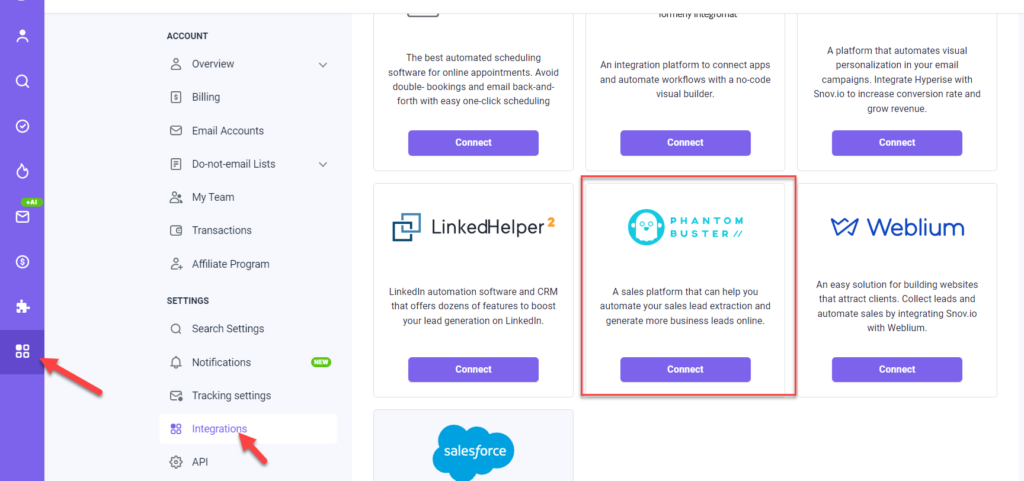
We will talk more about other integrations later.
Verify your email list
- Never send cold messages to email addresses that don’t exist.
- Trust me, Google and other email providers will find out super quick.
- If you keep sending invalid emails, you will get hard bounces. Your sender’s reputation is hit every time you receive a hard bounce.
The email verification functionality is already under construction in Snovio:
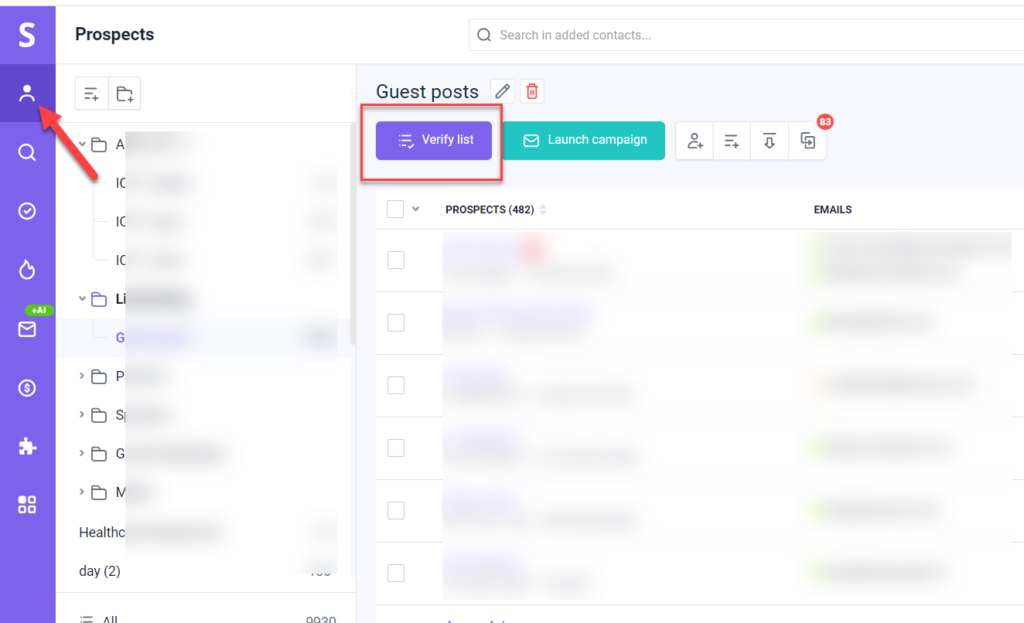
Only send to those with green status. These are the emails that exist and work.

What about the others? I recommend still checking them with 3 different tools.
They are more expensive, but they verify better:
Check only the controversial ones (orange). The red and green ones do not need to be checked again
- Setting up a Drip Campaign
Now, it’s time to customize the campaign itself.
It’s very simple. Go here and click create
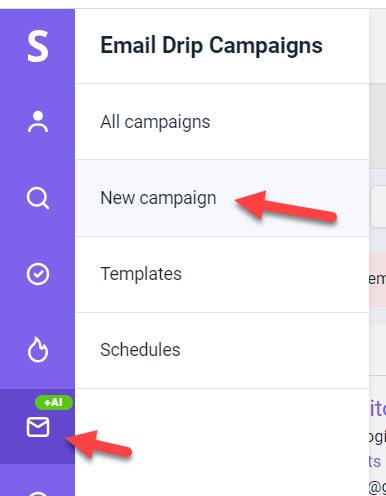

It all starts with the first letter. We drag it over and start writing.

Snovio will prompt you to use AI right away.

Check out the demo You are now without AI, but you must understand the difference between a good email and a bad one.
AI can’t replace a good marketer yet.
Master cold email subject lines
The subject line is one of the key factors based on which people decide whether to open your email or not.
Why is that so important? Because even an unbeatable offer matters little if no one opens your email in the first place.
And getting that click in the first place is much more complex than it sounds. According to Walsworth, one-third of recipients determine the email’s value based on its subject line, while nearly 70% regard it as spam solely because of the subject line.
Given these figures, it’s probably no surprise that Mailchimp estimates that the average email open rate for all industries is just 21.33%.
If the statistics above weren’t enough to convince you of the importance of a good email subject line, consider this:
Email subject lines that are too generic don’t get clicked on
A study conducted by Experian shows that companies using emails with personalized subject lines see a 37 percent increase in unique open rates when compared to emails with non-personalized subject lines.
This personalization can be as simple as including the recipient’s name or other relevant information that can improve engagement.
Lines that are too long don’t get clicked on mobile phones
According to review data published in 99firms, 85 % of recipients will first open an email on a mobile device. The numbers go up to 90% for those aged 25-34.
Why is this important?
Because it means any subject line you write should be optimized for mobile devices, including keeping the character length within an ideal range of 30 to 50 characters.
Subject lines that don’t convey a sense of urgency often get ignored.
Research by Invesp found that “subject lines that create a sense of urgency or exclusivity can lead to a 22% higher open rate.” Phrases like “limited time offer” or exclusivity (e.g., invitation-only events) can encourage recipients to open the email promptly.

These statistics demonstrate the crucial role that subject lines play in determining email open rates, spam marking, and overall engagement.
I recommend testing your subject line here before making your final selection – Omnisend.
Customization as the primary tool
According to recent statistics from Hubspot, personalizing your cold email messages increases your chances of receiving a response and building trust with the recipient.
When crafting customized messages, it’s helpful to gather additional information about the recipient beyond just their name:
- Location
- Job title
- Interests and hobbies
- Favorites (animals, colors, sports, etc.)
- School/university they went to
- Common connections
- Club memberships
- Recent challenges
- Accomplishments
- Mentions on websites, videos, podcasts, or webinars
Cold outreach email formulas
Let’s explore some tried-and-true cold email techniques (including templates) that can boost your response rates and yield positive outcomes.
Every cold email, whether initial or follow-up, should comprise an email subject line, email body content, call-to-action (CTA), and email signature.
As previously noted, the email open rate hinges significantly on the subject line. Meanwhile, the response rate depends on how well you researched your recipients and how relevant your offer is to their organization. Additionally, if you’ve included links or hyperlinked text, ensure the anchor words are enticing (but not misleading) to enhance your click-through rate.
Consider these cold email methods:
The BAB (Before – After – Bridge) formula
- Before: A paragraph on your prospect’s pain point.
- After: What your prospect’s business looks like with a solution you’re offering.
- Bridge: How your prospect can get there.
The SSS (Star – Story – Success) formula
- Star: Introduce the main character, who your prospect can identify with.
- Story: Tell a story where your character overcomes the same problem as your prospect.
- Success: Provide your prospect with the exact solution and explain how your character overcame the problem.
The ACCA (Awareness – Comprehension – Conviction – Action) formula
- Awareness: Show your prospect that you know what their pain point is.
- Comprehension: Explain how this pain point affects them, and tell them you have a solution.
- Conviction: Create a desire for the solution.
- Action: Call-to-action (CTA).
The PAS (Problem – Agitate – Solve) formula
The PAS formula, sometimes called a pessimistic version of BAB, can be effective in various situations. Determining which principle works best for you and your prospects is essential, or you can conduct an AB test to compare them.
- Problem: Open your cold email with the problem your prospect is facing.
- Agitate: Emphasize the problem until it “hurts.”
- Solve: Offer a solution to your prospect’s problem.
The AIDA (Attention – Interest – Desire – Action) formula
- Attention: Grab the prospect’s attention.
- Interest: Make it personal to engage their interest.
- Desire: Build desire for what you’re offering.
- Action: Ask for a response.
Cold email outreach templates that work
Here are a few cold email templates in addition to our outreach formulas that may be helpful:
#1 Mutual connection template to do networking
Dear {{Prospect Name}},
I hope this message finds you well. My name is {{Your Name}}, and I hold the position of Marketing Manager at {{Company Name}}.
Recently, while conversing with [Discussed with a Mutual connection person], I had the pleasure of learning about your commendable [skill or specific experience]. It’s evident that you excel as a [something of relevance to the person], and I wanted to extend my appreciation for your efforts in that area.
Additionally, I’ve come across an insightful article on [topic] that I thought might pique your interest. Given your expertise, I believe you’ll find it both valuable and engaging.
I’m hopeful that this can be the start of a productive dialogue between us.
Warm regards,
{{Professional email signature}}.
#2 Reach out to the prospect on the same LinkedIn group
Dear {{Prospect Name}},
I recently encountered your profile and was genuinely impressed to find someone actively involved in the [Community Name]. It’s indeed rare and encouraging to come across individuals who share our mutual passion for sales automation.
As professionals in this field, I believe we’re both on a constant quest to refine our sales strategies. I’d be keen to hear about your interests and any challenges you might be facing. There could be potential avenues where we could collaborate or assist one another.
I look forward to the possibility of connecting with you.
Warm regards,
{{Professional email signature}}.
#3 Giving a compliment to the prospect
Dear {{Prospect Name}},
I recently had the opportunity to review your contributions at {{Company_name}} and felt compelled to express my admiration for your work. Given my extensive experience in the {{industry}}, I believe I might offer insights or support that could be beneficial to you.
For a deeper dive into my perspectives, you can explore my regular writings on the subject at {{Blog_Link}}. I would highly value your feedback, and if it aligns with your schedule, perhaps we could arrange a brief 5-minute conversation regarding {{blog_topic}}? Here’s a link to my calendar for your convenience.
I look forward to the possibility of connecting with you.
Best regards,
{{Professional email signature}}.
#4 Using the AIDA formula (Attention, interest, desire and action) to get a reply from the prospect
Dear {{Prospect Name}},
Understanding the challenges faced by a {{prospect’s_role}}, particularly when it comes to addressing {{prospect’s_problem}}, I believe our {{name_solution}} might be of interest to you. It’s designed to not only alleviate these issues but also {{short_sales_pitch}}.
To provide a clearer picture, here’s feedback from one of our satisfied clients:
{{customer_testimonial}}. Should you wish to explore how our solution can benefit you similarly, I’d be keen to discuss this further. Would a brief conversation this week work for you? You can schedule a time via this link to my calendar.
Best regards,
{{Professional email signature}}.
#5 Asking a relevant question in the email
Dear {{Prospect Name}},
I hope this message finds you well. Are you interested in exploring ways to {{product’s_benefit}}? Recognizing your busy schedule, I’ll keep this concise.
My name is {{your_name}}, representing {{company’s_name}}. I’ve curated a few insights that might assist you in {{prospect_work}}:
{{tip_1}}, {{tip_2}}.
I understand that diving deep into these suggestions might be challenging with your commitments, which is precisely where {{your_product}} comes into play. Would you be available for a brief 15-minute conversation to discuss this further?
Warm regards,
{{Professional email signature}}.
#6 Start the conversation with the help of the latest news in the industry
Dear {{Prospect Name}},
Firstly, my heartfelt congratulations on the recent funding milestone. It’s evident that your company is making significant waves in the {{industry}}, especially with the commendable mentions on {{website_name}}.
I eagerly anticipate hearing about more of your achievements shortly. My name is {{your_name}}, and I’m associated with {{company’s_name}}. We specialize in {{your_solution}}. Should you ever need assistance in this domain, please don’t hesitate to reach out.
Best wishes,
{{Professional email signature}}.
I’m sure these formulas and templates will inspire you to create your excellent letters.
BONUS TIP
Boost your conversions with dynamic landing pages
You can customize them with videos, texts, logos, and Calendly links. Everything works automatically. There’s an excellent tool for this – hyperise.io (integrates with Snovio, of course)
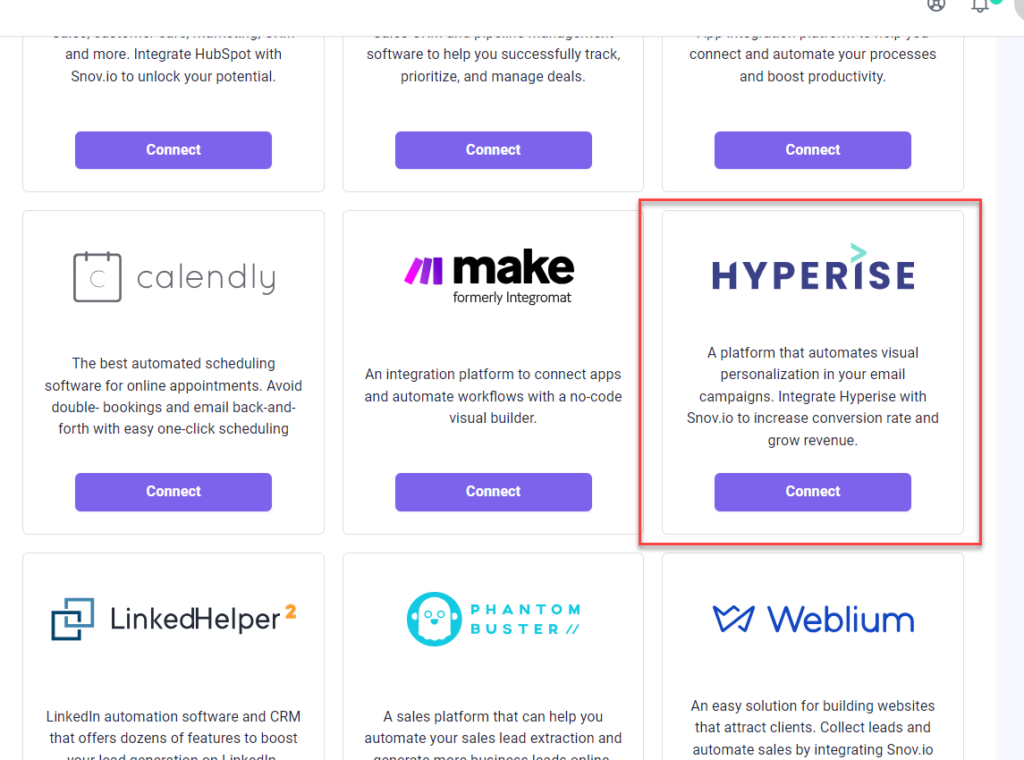
When should you send a cold email?
According to GetResponse, the optimal time to send emails to potential customers is from 8 a.m. to 3 p.m. However, every company may have a recommended time to send cold emails.
Do you want to know which day is most effective for sending cold emails? Based on a study linked below, Monday and Wednesday have the highest open rates and are the best days to send cold emails.
It’s essential to recognize that there’s no one-size-fits-all approach when it comes to crafting cold emails. Your email’s effectiveness depends on various factors, such as your specific goals, the characteristics of your recipients, and the time zone you’re working in. It’s crucial to remember that there’s no magic formula or specific hour or day that will guarantee success unless you’ve put in the effort to perfect your email.
When it comes to my schedule, it looks like this. No weekends. Only working hours
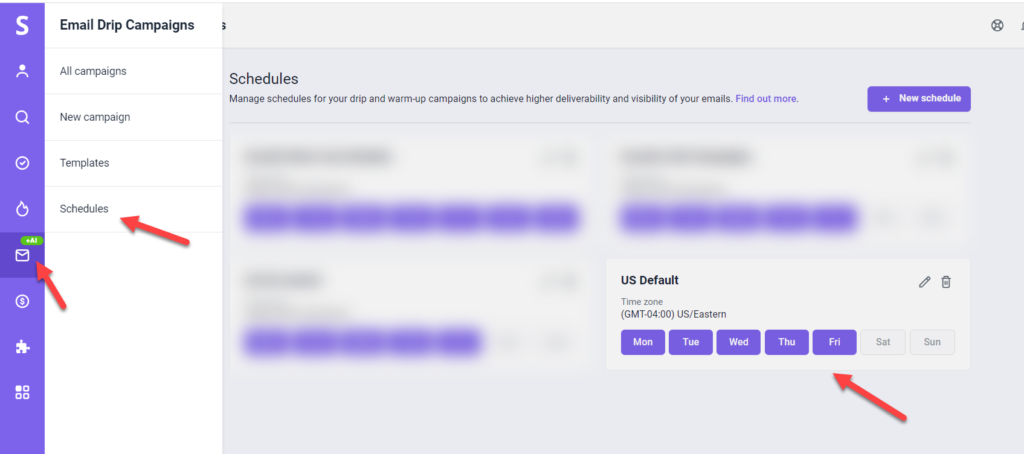
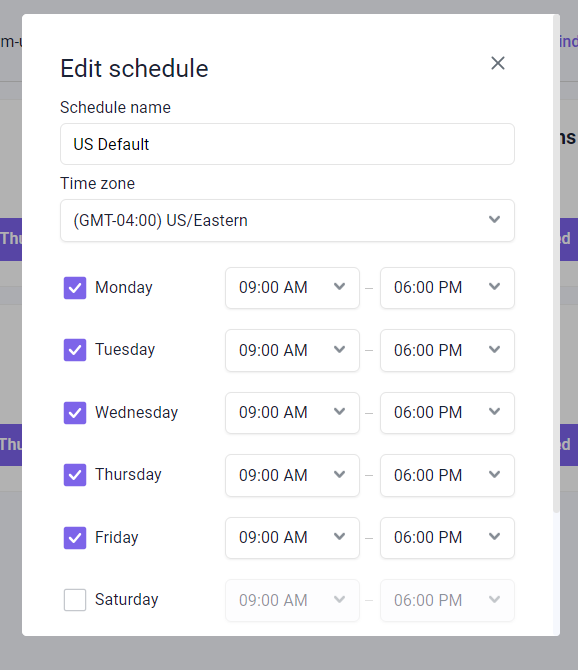
Final check before hitting the send button
After completing your cold email, asking yourself a few questions would be helpful to ensure its effectiveness. Ensure an exceptionally effective cold email by:
- You have a clear goal stated in your cold email.
- You have identified the correct person, department, and position in the company who matches your ideal target prospect.
- Your cold email should be attention-grabbing, personalized, specific, and persuasive.
- Include a clear subject line and a solid call to action.
- Paste your email’s content into Grammarly to check for typos and other errors. Remember to review the subject line and preheader for any mistakes.
- It would be advisable to send a trial version of the email to your own email inbox.
- View the test email on a desktop and a mobile device like your phone.
- Send a test email to a couple of people you trust and who aren’t afraid to give you an honest critique. They offer fresh eyes that may catch something you didn’t.
- Check every single link in the email – including linked pictures.
- Your email appears to contain no elements that could be considered spam.
- This is the perfect time to send your cold email.
- You A/B test every cold email.
If everything checks out, your cold email outreach should be successful. Keep in mind that your job is not complete after the first email. Follow-up is crucial, so keep reading to learn why it matters and how to do it correctly.
Remember to send follow-up emails
Being patient and not too aggressive when contacting potential customers via cold email is essential. Instead of immediately trying to close a deal, it’s better to establish a rapport and build trust. This can be achieved by sending follow-up emails after the first message, as not doing so is a common mistake marketers and salespeople make.
In fact, sending more follow-up emails can triple your reply rate. However, it’s important to strike a balance and not overwhelm recipients. Experts recommend sending about 9 follow-ups, but studies show that most sales close after 5 follow-ups.
When following up with prospects, consistency is vital without overwhelming them. Timing is critical, so follow-up after an event can serve as a natural trigger. As for how long to wait before following up, there’s no one-size-fits-all answer.
However, here’s the framework I use:
- The 2-day delay between emails 1 and 2
- The 3-day delay between emails 2 and 3
- The 4-day delay between emails 3 and 4
In Snovio, it will look like this:
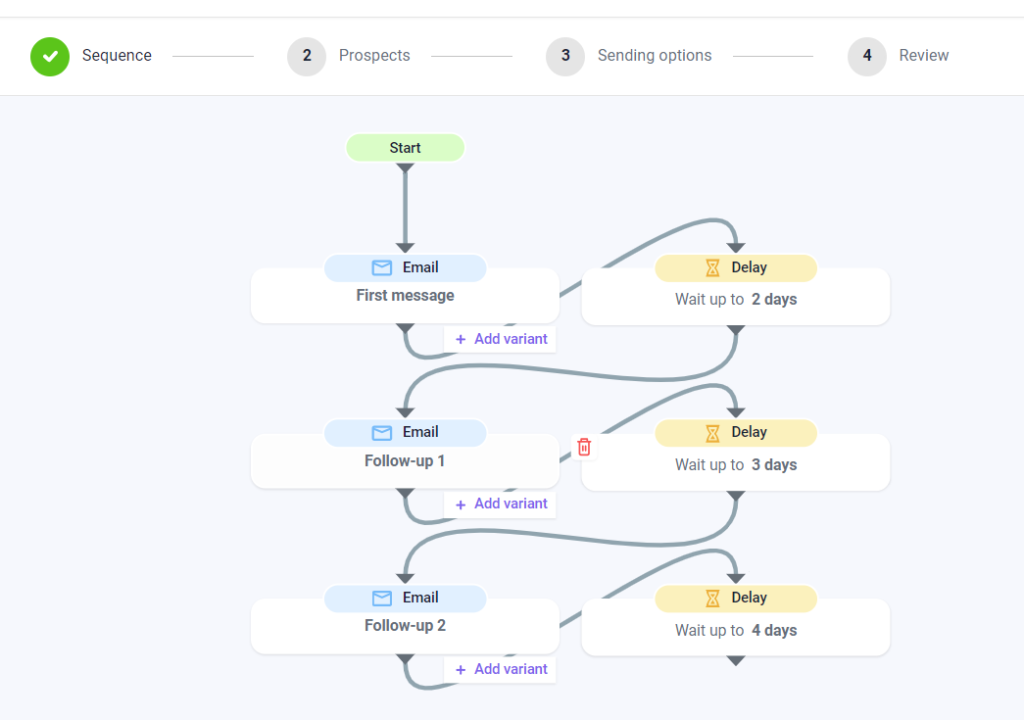
Refrain from repeating yourself or being too pushy in your follow-up emails. Add value and build trust with each message. If you don’t get a response after four to eight emails, send a breakup email, but be kind and don’t burn any bridges. Let them know they can reach out if they change their mind.
A/B test your emails to discover top performers
To gauge the effectiveness of your cold email, it’s important to track specific metrics. These include the open rate, which indicates how well your subject line is performing; the response rate, which shows whether your message is resonating with your target audience; and the conversion rate, which measures the success of your sales pitch.
To optimize your cold emails, you must experiment with variations and test which ones generate the most clicks and sales. You can test various components, such as subject lines, opening lines, body copy, CTAs, timing, and personalization. When conducting A/B testing, it’s crucial to choose one variable at a time and compare two slightly different versions of that variable.
You should also set clear criteria for determining the winning version and split your target audience into two equally sized groups to test each variant. Avoid testing too many variables simultaneously, as isolating their effects can make it hard.
You can optimize your cold emails and achieve your desired results with patience and persistence.
To add a variant for testing, click here:
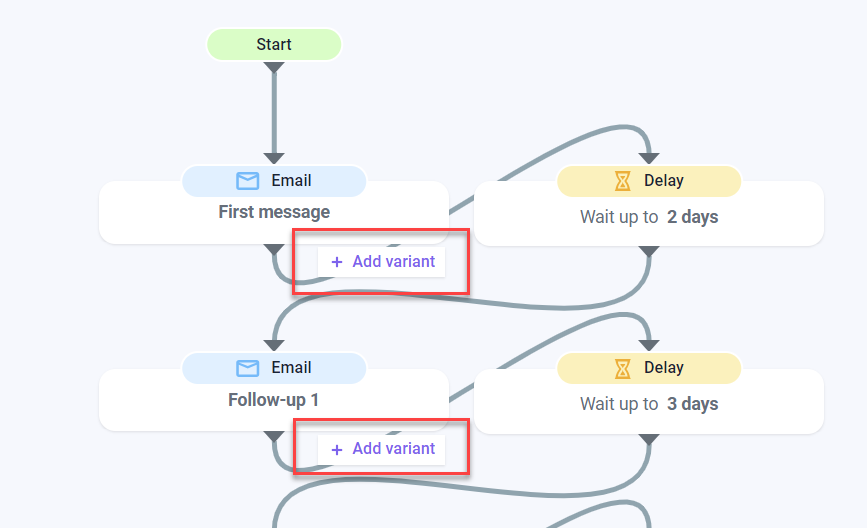
Let’s launch the campaign Once all the letters are prepared, we move on to the next step:
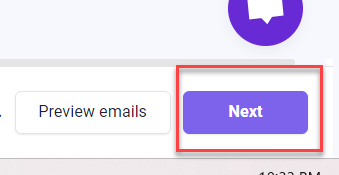
In the next step, select the list to which we will send this series of emails:
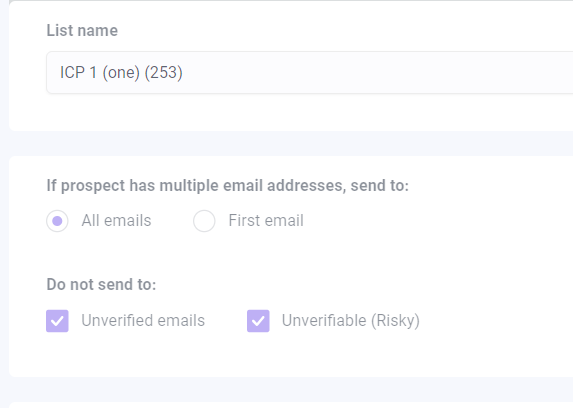
It is important to check these. Hit the following button:
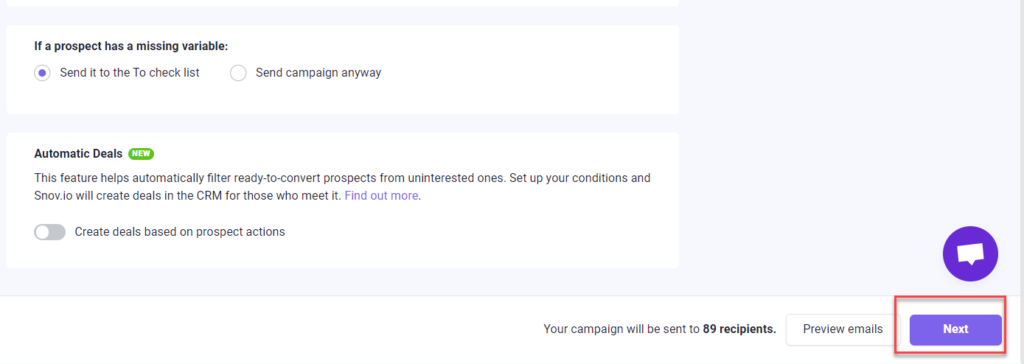
Select the sender and see what the signature will be:
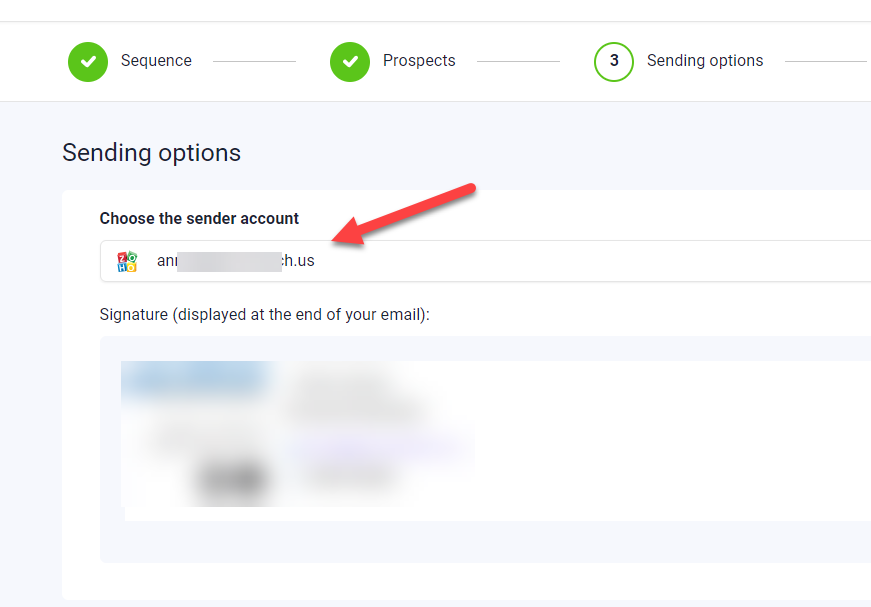
Check all the boxes:

Choose when to send it:
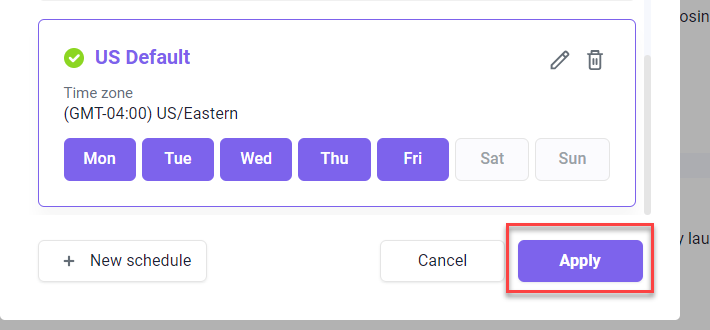
If you need to customize when to start and end a company, then do that and move on:
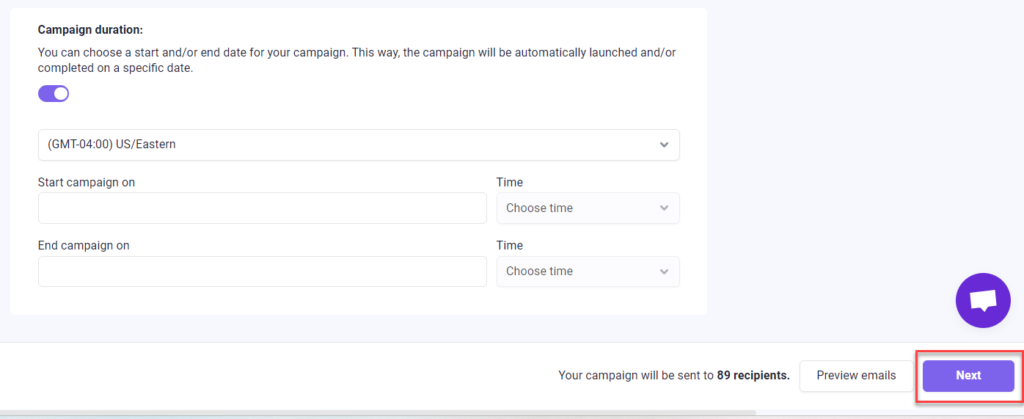
Check if everything is correct, and don’t rush to press the start button. For starters, see how your letters look like for specific people:
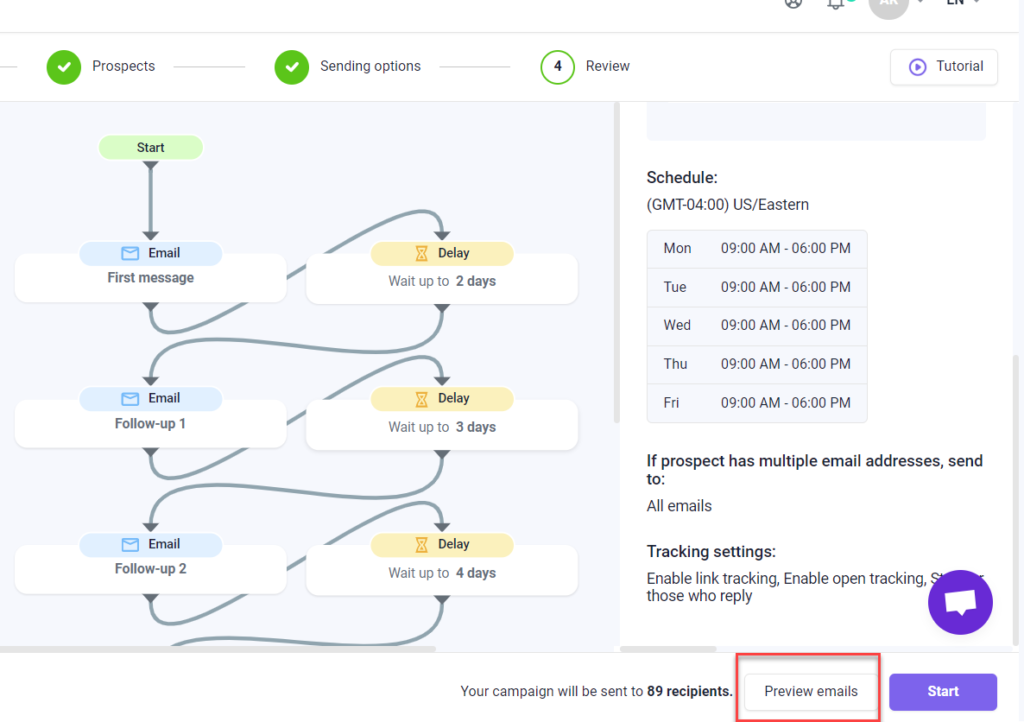
Are you all enjoying yourselves? Then press the start button 🙂

Building advanced sales workflows
I recommend using integration to get the most out of your cold outreach. There are two types of integrations:
- Built-in integrations
- CRM (Pipedrive or HubSpot)
- Calendly
- Any integrations using Zapier or Make
- Slack, for example (with Make)
Snovio provides detailed instructions on how to set up CRM (Pipedrive or HubSpot) and Calendly integrations:

Instant reaction on every lead with Slack integration
Every time we get a n ew reply from a sales campaign, we get an instant Slack notification.
You can use Zapier or Make (formerly Integromat) to make it work, and the whole workflow will look like this:
I recommend using Make. It’s cheaper
Psychological insights in B2B decision-making
Understanding the psychology behind decision-making in B2B environments is key to crafting persuasive messaging that resonates with your audience. Unlike B2C, where decisions are often driven by emotion or impulse, B2B decisions are typically more rational and process-oriented, but still influenced by psychological factors.
The role of emotions: While B2B decisions are largely logic-based, emotions still play a significant role. A study by the CEB, now Gartner, revealed that B2B customers are significantly more emotionally connected to their vendors and service providers than consumers. This connection can be leveraged in cold outreach by focusing on building trust and demonstrating understanding of the prospect’s challenges and goals.
Influence of authority and social proof: In B2B decision-making, the authority of the source and social proof are highly influential.
Importance of reciprocity: The principle of reciprocity is powerful in B2B interactions. When companies provide something of value without immediate expectation of return, they create a sense of obligation and goodwill. Offering valuable insights, whitepapers, or free consultations can trigger this sense of reciprocity and open doors to further engagement.
Decision fatigue in B2B: Decision-makers in the B2B realm often face a plethora of choices and information, leading to decision fatigue. Simplifying choices and providing clear, concise information can help alleviate this fatigue and guide prospects towards a decision.
By understanding and applying these psychological principles, B2B marketers can craft messages that are not only informative but also deeply resonant with their audience’s underlying motivations and behaviors.
Performance metrics in B2B cold outreach
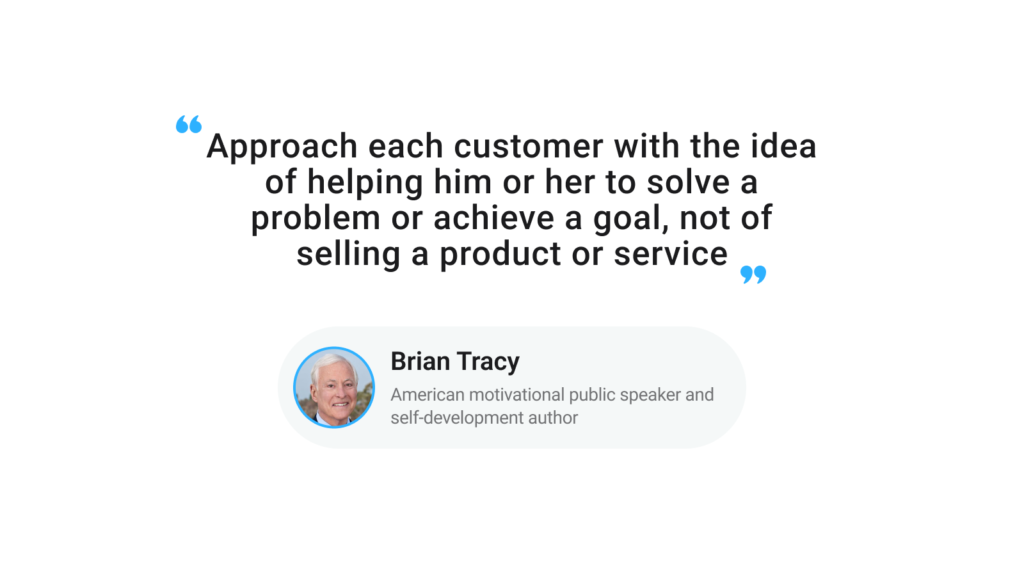
Measuring the success of B2B cold outreach campaigns is crucial for understanding their effectiveness and areas for improvement. Key performance indicators (KPIs) provide tangible benchmarks that can guide marketers in refining their strategies for better results.
Email open rate: A primary KPI in cold outreach is the email open rate, which indicates how many recipients are opening your emails. A report from Mailchimp suggests that the average open rate for B2B emails is around 21%. This metric is a strong indicator of how compelling your subject lines are and the initial interest level in your content.
Response rate: The response rate measures the percentage of recipients who take the time to reply to your email. While industry benchmarks vary, a response rate of around 2-3% is considered good for B2B cold emails. This KPI reflects the relevance and engagement potential of your email content.
Click-through rate (CTR): CTR indicates the effectiveness of your email in encouraging recipients to click on links, such as a call-to-action. The average CTR for B2B emails hovers around 2.5%, according to Campaign Monitor. A higher CTR suggests that your message is successfully motivating recipients to take the next step in the sales process.
Conversion rate: Conversion rate is the percentage of recipients who complete a desired action, such as signing up for a webinar or making a purchase. This KPI directly correlates with the ultimate success of your cold outreach in driving business outcomes.
Bounce rate: Bounce rate is the percentage of your emails that aren’t delivered. It’s essential to keep this rate low, as high bounce rates can harm your sender reputation. A bounce rate below 2% is generally acceptable.
Lead generation rate: This KPI measures how effectively your outreach converts prospects into leads. A healthy lead generation rate is a sign of an effective outreach strategy that aligns well with your target audience’s needs.
Localization strategies for international B2B cold outreach
You’re not just selling a product or service; you’re providing a solution to a problem. Make that clear in your outreach.SETH GODIN, MARKETING GURU
In a global business environment, localizing your B2B cold outreach is essential for effective communication across different cultures and regions. Tailoring your approach to suit each unique market demonstrates respect and understanding, which are key in building international business relationships.
Cultural sensitivity and adaptation: One of the first steps in localization is understanding and respecting cultural nuances. For instance, a study by HubSpot found that emails in Germany have a higher response rate when they’re more formal and direct, compared to the more casual style preferred in the U.S. This highlights the need to adapt your communication style to align with cultural expectations.
Language and tone: Even if English is a common business language, translating your content into the local language can significantly enhance engagement. According to CSA Research, 75% of consumers prefer to buy products in their native language. This suggests that localizing your email content can lead to better reception and higher response rates.
Consideration of local regulations: It’s also crucial to be aware of local laws and regulations regarding marketing and data privacy. For example, countries in the EU are governed by GDPR, which has specific requirements for consent and data handling. Failing to comply can not only lead to legal issues but also damage your reputation.
Local holidays and events: Acknowledging local holidays and events in your outreach can show that you value and understand the local culture.
Visual elements and design: The visual aspect of your emails should also be localized. Color schemes, imagery, and design elements that resonate well in one culture might not have the same effect in another. For instance, colors that are considered lucky or positive in one culture might have negative connotations in another.
By implementing these localization strategies, you can ensure that your cold outreach resonates more effectively with international audiences. It’s not just about speaking the language but also understanding and respecting the cultural context.
Advanced techniques in B2B cold outreach
Embracing advanced techniques in B2B cold outreach can significantly enhance the effectiveness of your campaigns. Techniques like A/B testing, segmentation, and behavioral triggers allow for more personalized and data-driven approaches, leading to better engagement and conversion rates.
A/B testing for optimized messaging: A/B testing, or split testing, is a method of comparing two versions of an email to see which one performs better. According to a study by Litmus, brands that A/B test every email see email marketing returns that are 37% higher than those of brands that never include A/B tests. This underscores the importance of testing elements like subject lines, email content, and CTAs to identify what resonates best with your audience.
Segmentation for targeted outreach: Segmentation involves dividing your email list into smaller, more targeted groups based on specific criteria like industry, company size, or engagement level. HubSpot reports that email segmentation can increase CTR by up to 50%. By delivering content that is more relevant to each segment, you can significantly improve the engagement and effectiveness of your outreach.
Behavioral triggers for timely engagement: Behavioral triggers are automated emails that are sent based on a prospect’s actions, like visiting a particular webpage or downloading a resource. These triggers ensure timely and relevant follow-up.
Advanced analytics for strategy refinement: Utilizing advanced analytics tools can provide deep insights into the performance of your outreach campaigns. These tools can track metrics like open rates, click rates, and conversion rates, enabling you to continuously refine your approach based on data-driven insights.
Predictive analytics for lead scoring: Predictive analytics uses historical data and machine learning to score leads based on their likelihood to convert. This approach can optimize your outreach efforts, ensuring that you focus on the most promising prospects.
By incorporating these advanced techniques into your B2B cold outreach strategy, you can ensure that your campaigns are not only more personalized and engaging but also continuously evolving based on solid data and insights.
Future trends in B2B cold outreach

Keeping abreast of emerging trends is crucial in the ever-evolving landscape of B2B cold outreach. As technology advances and buyer preferences shift, the strategies and tools used for cold outreach are also expected to undergo significant changes. Understanding these trends can help businesses stay ahead and adapt their outreach strategies effectively.
AI and machine learning in personalization: AI and machine learning are expected to play a major role in personalizing cold outreach at scale. Gartner predicts that by 2025, AI will power 75% of commercial enterprise apps. This advancement will enable hyper-personalized content creation, allowing for more targeted and effective outreach.
Voice technology and conversational AI: With the rise of voice technology and conversational AI, we’re likely to see an increase in voice-based cold outreach. This technology offers a more natural and interactive way of engaging with prospects, potentially increasing the effectiveness of outreach efforts.
Predictive analytics for enhanced targeting: Predictive analytics will become more refined, enabling businesses to target prospects with unprecedented precision. By analyzing patterns in data, companies can identify the most promising leads, optimizing resources and increasing the chances of successful outreach.
Blockchain for enhanced trust and transparency: Blockchain technology could emerge as a key player in enhancing trust and transparency in B2B communications. This technology can provide a verifiable and immutable record of transactions and interactions, building credibility in cold outreach campaigns.
Increased focus on data privacy and compliance: With growing concerns over data privacy, future cold outreach strategies will likely place greater emphasis on compliance and ethical practices. This approach will not only be about adhering to laws but also about gaining and maintaining the trust of prospects.
Integration of offline and online channels: A seamless integration of offline and online outreach is expected to become more prevalent. This holistic approach can provide a more comprehensive and cohesive brand experience, enhancing the effectiveness of outreach strategies.
Sustainable and ethical marketing: As sustainability becomes a global priority, we can anticipate a shift towards more sustainable and ethical marketing practices in cold outreach. This change will cater to the increasing preference of businesses and consumers for environmentally and socially responsible brands.
Staying informed about these future trends will enable businesses to adapt and refine their B2B cold outreach strategies, ensuring they remain effective and relevant in a changing business environment.
Wrapping up
Cold emails can be incredibly effective when personalized for a specific audience. But with no proper planning and preparation, your cold email outreach is bound to fail.
Fortunately, my guide makes it a breeze to approach your cold emails proactively.
Ensure your cold email copy is as good as possible, and you’ll be favored with jacked-up open, click-through, and response rates. Even better – you’ll be able to build long-term, reliable business relationships.
When creating your cold email strategy, remember to follow these 8 principles:
- Set clear goals;
- plan;
- prepare for your cold email outreach because planning is half of the hard work done;
It is critical to comply with email regulations such as CAN-SPAM, GDPR, and any other applicable laws in the location of your customers. Identify your potential customers, do extensive research to get to know them better, and gather their contact and other relevant details.
- Use cold outreach tools to find prospects and automate your emails.
- Always double-check and triple-check your cold email before you send it.
- Don’t forget to follow up.
- Perform A/B testing and select the versions that yield the best performance.
- Optimize accordingly.
- Measure your campaign’s results.
Questions You May Have
-
How can I ensure my cold emails comply with anti-spam laws like GDPR and CAN-SPAM?
To comply with anti-spam laws, it’s essential to obtain consent, include an opt-out option, and be transparent about your identity. Tools like Snov.io offer features that help maintain GDPR compliance by validating prospects’ consent. Additionally, consult with legal resources or utilize compliance services to ensure your outreach strategies adhere to the latest regulations.
-
What are some effective ways to personalize my cold outreach emails?
Personalization can be achieved by researching your prospect and tailoring the email content to their specific needs and industry. Using a tool like Hyperise.io can add a personalized touch with dynamic images. For more sophisticated personalization, Apollo.io provides insights that can help craft messages resonating with the recipient’s business context.
-
How often should I follow up with a prospect if I don’t receive a reply?
Persistence is key in cold outreach; however, it’s important to balance it with respect for the prospect’s time. A typical follow-up strategy might involve a sequence of 3-5 emails spaced out over a few weeks. Tools like Warmupinbox.com can help automate this process, ensuring your follow-ups are timely and consistent.
-
Can I automate finding and verifying email addresses for cold outreach?
Absolutely, automating the process saves time and increases efficiency. Hunter.io is excellent for finding email addresses associated with a domain, and Usebouncer.com can verify them to maintain a high deliverability rate. These tools streamline the prospecting process, allowing you to focus on crafting compelling messages.
-
How do I measure the success of my cold outreach campaigns?
-
What is the best time and day to send cold outreach emails?
While the best time can vary depending on your audience, studies suggest that midweek days, particularly Tuesday, have higher open rates. Scheduling tools integrated within platforms like Zoho Mail can help automate sending emails at optimal times. It’s also beneficial to test different times with your audience to find what works best for your specific context.
-
How do I avoid my cold emails landing in the spam folder?
To avoid the spam folder, ensure your emails are well-crafted with a clear subject line, personalized content, and a reputable sender reputation. Email warming services like Warmy.io can help improve your sender score. Additionally, using an email verification tool like Usebouncer.com to clean your list can significantly reduce the chances of being marked as spam.
Join my monthly newsletter
Start getting exclusive B2B marketing tips that I only share with email subscribers

![8 Top Content Marketing Assets 2025 [Infographic] content marketing assets](https://khomichenko.com/wp-content/uploads/2020/02/content-marketing-assets-770x515.png)
